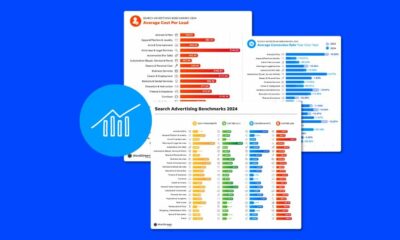SOCIAL
Inside the creator marketing trends expected to go viral in 2024

In a world that’s increasingly online, the creator economy is primed for the spotlight. Digital video consumption has reached an all-time high, led by creator content, and advertisers are shifting more dollars toward smartphone-yielding creatives. Some are willing to bet that the days of creators being viewed as a supplement to advertisers’ playbooks are gone. Instead, creators could become the foundation.
“Starting first with creators when it comes to advertising is definitely the wave of the future,” said Ali Fazal, vice president of marketing for creator management platform Grin.
This year, 44% of marketers plan to up their creator investment, with an average spending increase of 25%, according to a creator economy report by IAB and TalkShoppe. The landscape was last valued at $250 billion and is expected to grow to a whopping $480 billion by 2027, Goldman Sachs forecasts. As creators become more cemented in advertiser budgets, the role they play could grow, graduating from the experimental bucket to a category of their own. While the terms creator and influencer are often used interchangeably, the key difference is purpose, with an influencer being a type of a creator that uses their platform to promote products and influence buying decisions.
Influencer marketing agency Billion Dollar Boy is among those experimenting with the concept of creator-led advertising. The agency last year teamed with Lipton Iced Tea for an international creator-led campaign that spanned digital out-of-home, social media and experiential and was centered around an original song performed by TikToker Matt Storer with support from a slew of other creators. In total, the campaign achieved a video view-through rate of 23.9% while the brand saw a sales uptick of 15% in Australia during the campaign’s two-week run.
The example above signals the edge that creator-based advertising provides over traditional tactics in the digital age, according to Ed East, Billion Dollar Boy’s founder and global CEO.
“[Previously] you would have had creator activity, influencer marketing, bolted onto a plan. Now, creator activity needs to be at the heart of your plan,” said East.
As advertisers ramp up their creator investments, trends anticipated for 2024, like new ways of measuring success and long-form video’s resurgence, could change strategies for some. Meanwhile, growing hype around generative artificial intelligence (AI) and social commerce could offer brands fresh opportunities to break through.
The science of being #influenced
Beyond consumers’ general appreciation of creator content are signs that such content is more meaningful than studio-made ads, like scripted video content that appears on TV, per the IAB’s report. Creator ads have a 1.4-times greater impact on building brand loyalty and a 1.3 times greater impact on inspiring brand advocacy, according to the findings.
It’s worth noting that an appreciation for creator content comes as consumers are posting less content of their own across social channels, according to Ellyn Briggs, a brands analyst for decision intelligence company Morning Consult. The insight could help lend more visibility to brand and creator collaborations, though what Briggs forecasts to be an “uber volatile landscape” for social media marketers this year could usher in more consumer skepticism.
“Influencers especially are going to need to fill a content void,” Briggs said. “But with that brings an additional level of attention and potential scrutiny to influencer activity, which, as we’ve seen [in 2023], can increase the chances of backfiring.”
Creator campaigns gone wrong are nothing new, Briggs added, pointing to Shein’s all-expenses-paid influencer trip last year, which faced backlash when those involved gushed about the company’s often-criticized labor practices. Though consumers these days are increasingly likely to call out inauthentic content, they continue to place deep trust in creators, tasking creatives to rethink how they reach their audiences.
“I think we can officially say that in 2024, using follower count to determine an influencer’s potential success is dead.”
Ali Fazal
Vice president of marketing, Grin
“The way influencers sell is going to change because we are seeing that consumers are voicing their frustrations with things like overconsumption and constantly being sold to,” said Megumi Robinson, vice president at digital PR firm Belle Communication.
A trend Robinson expects to grow in 2024 is that brands and creators will be more selective around who they partner with, and repeat partnerships will be more common. This year is also likely to see less pay-to-play tie-ups where creators take on brand deals despite having no real connection to them, according to Fazal, who noted that consumers aren’t blind to such partnerships.
“It’s pretty obvious to me that Nicole Kidman does not use Lancôme makeup,” Fazal said with a laugh.
For more relevant content, Fazal also anticipates that marketers will increasingly hire creators to produce content specifically for brand-owned channels, versus sharing the content to the creator’s pages. Such is the case for Uber, which built out a TikTok creator strategy that leverages no more than six creators at any given time to make content for the brand.
“Creators being on their own and working with no confines are able to be a lot more innovative, bold, daring, and as a result, the content is more effective,” Fazal said.
Follower count is ‘dead’
A focal point in the creator space has often been the use of either micro or macro influencers, each lauded for different reasons: micro influencers typically carry stronger engagement rates despite smaller followings, while macro influencers have massive reach. However, Robinson anticipates the best of both worlds will be found in a rising mid-tier category, classified by the exec as those yielding 50,000-800,000 followers.
“What we’re seeing is a lot of these micro creators, who might have a little bit smaller audiences but really strong engagement rates, they are gaining more followers and growing, but they’re able to retain that level of engagement rate,” Robinson said.
As the landscape evolves, the use of follower count as a sole consideration is likely to fizzle out of the conversation, Fazal predicts, noting that the metric alone isn’t as strong of a success indicator compared to aspects like engagement. Additionally, as brands strive to build a more diverse creator strategy — another forecast from the exec — follower count often favors those not from diverse backgrounds.
“I think we can officially say that in 2024, using follower count to determine an influencer’s potential success is dead,” said Fazal.
Fazal also anticipates more variety in content formats, noting that while short-form videos aren’t expected to fall from popularity, longer-form content will see a resurgence as consumers indicate a want for granular insights and deeper connections. Such has become the norm on top-dog TikTok, where viewers often request a part two and three on shorter videos, a sentiment TikTok appeased with the addition of 10-minute videos. For marketers, the opportunity to tell a longer story could make a difference, especially during the key holiday marketing period.
“Over time there has become this perception that millennials and Gen Z in particular can’t focus, we have to make things quick, and we’ve seen that this bet has failed time and time again,” Fazal said.
Still, short-form has been a growing focus for platforms, particularly TikTok, Instagram and YouTube, with the latter two consistently layering in new features and monetization tools for their Reels and Shorts products in a bid against TikTok. Social media is expected to see increased spend from advertisers in 2024, forecasted to account for $227.2 billion of ad spending this year. The boost comes as e-commerce marketing remains strong, with social platforms often fitting well into marketers’ customer acquisition and loyalty strategies.
Beyond what Fazal labels as the “big three” platforms for influencer content, others have similarly ramped up efforts to court both creators and advertisers. Snapchat recently began experimenting with a creator-led content series concept and added sponsored links to its My AI generative AI chatbot. Accordingly, East anticipates the platform could take a bigger role in the creator landscape.
“[Snapchat] appears to be the talk of the town because of engagement and the monetization opportunity they’re now offering,” East said.
Social commerce, AI present opportunity
As marketers map out their creator plans this year, a key focal point has the potential for social commerce. The interest follows the recent debut of TikTok Shop in the U.S., which has so far seen tepid results, though brands have expressed excitement. For some, it has proven to be a major opportunity — beauty brand BK Beauty activated TikTok Shop and within three months said it had more than doubled revenue, according to Adweek.
“We’ve already seen a lot of early signs that TikTok Shop is a big success,” Fazal said.
Total social commerce sales in the U.S. are expected to grow steadily from $67 billion in 2023 to over $144 billion by 2027, per Insider Intelligence. More broadly, for brands using influencers, Briggs recommends that they take note of the types of content favored by social media users, like product hauls and daily routine videos, which have been successful for driving purchases. Specifically, 53% of Gen Zers made a purchase after watching a “review” video on social, while haul and get ready with me (GRWM) videos drove 40% and 37% to purchase, respectively, per Morning Consult data.
The seamless shopping experience touted by social commerce could be what elevates the playing field, with 46% of buyers indicating that they are interested in buying products from social media with a one-stop shop experience, according to 2023 Comscore data shared with Marketing Dive. Still, as experiments in the space grow, Fazal urges marketers to adjust their expectations for social away from being a path to instant purchase.
“A lot of times when people think of influencer marketing, they will compare it or benchmark it against other advertising channels like paid ads, which are meant to be first touch conversion. But I would say to think of influencer marketing the same way you would think of a TV commercial or a billboard in that it requires multiple impressions to be successful,” Fazal said.
Among other questions under consideration is how generative AI could serve the creator space. Particularly, the tech could provide efficiencies for creators by streamlining back-end tasks like planning and organizing, Fazal said. Influencer-focused companies, including both Billion Dollar Boy and Grin, have also joined the hype with services that hone a focus on the tech.
“I do think in 2024 we might see more of this influencer-plus-AI combination.”

Ellyn Briggs
Brands analyst, Morning Consult
There’s also the concept of virtual influencers, like Miquela, who has already teamed with brand Pacsun, that could potentially come more into the mainstream as AI helps the computer-generated figures look more lifelike.
“These virtual personalities, created using advanced AI technologies, can offer brands new and innovative ways to engage with audiences, especially in the realms of fashion, technology, and entertainment,” said Alex Dahan, founder and CEO of global creator marketing company Open Influence.
Still, while virtual influencers offer some advantages over actual creators, like the ability to promote anything without qualms, the human element is key to forming authentic connections. Likely not a shock, analysis from Morning Consult has found that consumers trust recommendations by influencers far more than those from AI.
“That being said, I do think in 2024 we might see more of this influencer-plus-AI combination,” Briggs added.
Similar to broader applications of AI, the question of where AI fits within creator marketing is yet to be answered. While creators could benefit from using the tech for mundane tasks, allowing for extra time to be creative, those who grow overly reliant on it could raise red flags among an already observant consumer base, Robinson said.
“It will be very apparent, those who might just totally rely on AI, and that’s going to erode trust and authenticity, and could then make consumers even more skeptical,” the exec said.
SOCIAL
12 Proven Methods to Make Money Blogging in 2024

 This is a contributed article.
This is a contributed article.
The world of blogging continues to thrive in 2024, offering a compelling avenue for creative minds to share their knowledge, build an audience, and even turn their passion into profit. Whether you’re a seasoned blogger or just starting, there are numerous effective strategies to monetize your blog and achieve financial success. Here, we delve into 12 proven methods to make money blogging in 2024:
1. Embrace Niche Expertise:
Standing out in the vast blogosphere requires focus. Carving a niche allows you to cater to a specific audience with targeted content. This not only builds a loyal following but also positions you as an authority in your chosen field. Whether it’s gardening techniques, travel hacking tips, or the intricacies of cryptocurrency, delve deep into a subject you’re passionate and knowledgeable about. Targeted audiences are more receptive to monetization efforts, making them ideal for success.
2. Content is King (and Queen):
High-quality content remains the cornerstone of any successful blog. In 2024, readers crave informative, engaging, and well-written content that solves their problems, answers their questions, or entertains them. Invest time in crafting valuable blog posts, articles, or videos that resonate with your target audience.
- Focus on evergreen content: Create content that remains relevant for a long time, attracting consistent traffic and boosting your earning potential.
- Incorporate multimedia: Spice up your content with captivating images, infographics, or even videos to enhance reader engagement and improve SEO.
- Maintain consistency: Develop a regular publishing schedule to build anticipation and keep your audience coming back for more.
3. The Power of SEO:
Search Engine Optimization (SEO) ensures your blog ranks high in search engine results for relevant keywords. This increases organic traffic, the lifeblood of any monetization strategy.
- Keyword research: Use keyword research tools to identify terms your target audience searches for. Strategically incorporate these keywords into your content naturally.
- Technical SEO: Optimize your blog’s loading speed, mobile responsiveness, and overall technical aspects to improve search engine ranking.
- Backlink building: Encourage other websites to link back to your content, boosting your blog’s authority in the eyes of search engines.
4. Monetization Magic: Affiliate Marketing
Affiliate marketing allows you to earn commissions by promoting other companies’ products or services. When a reader clicks on your affiliate link and makes a purchase, you get a commission.
- Choose relevant affiliates: Promote products or services that align with your niche and resonate with your audience.
- Transparency is key: Disclose your affiliate relationships clearly to your readers and build trust.
- Integrate strategically: Don’t just bombard readers with links. Weave affiliate promotions naturally into your content, highlighting the value proposition.
5. Display Advertising: A Classic Approach
Display advertising involves placing banner ads, text ads, or other visual elements on your blog. When a reader clicks on an ad, you earn revenue.
- Choose reputable ad networks: Partner with established ad networks that offer competitive rates and relevant ads for your audience.
- Strategic ad placement: Place ads thoughtfully, avoiding an overwhelming experience for readers.
- Track your performance: Monitor ad clicks and conversions to measure the effectiveness of your ad placements and optimize for better results.
6. Offer Premium Content:
Providing exclusive, in-depth content behind a paywall can generate additional income. This could be premium blog posts, ebooks, online courses, or webinars.
- Deliver exceptional value: Ensure your premium content offers significant value that justifies the price tag.
- Multiple pricing options: Consider offering tiered subscription plans to cater to different audience needs and budgets.
- Promote effectively: Highlight the benefits of your premium content and encourage readers to subscribe.
7. Coaching and Consulting:
Leverage your expertise by offering coaching or consulting services related to your niche. Readers who find your content valuable may be interested in personalized guidance.
- Position yourself as an expert: Showcase your qualifications, experience, and client testimonials to build trust and establish your credibility.
- Offer free consultations: Provide a limited free consultation to potential clients, allowing them to experience your expertise firsthand.
- Develop clear packages: Outline different coaching or consulting packages with varying time commitments and pricing structures.
8. The Power of Community: Online Events and Webinars
Host online events or webinars related to your niche. These events offer valuable content while also providing an opportunity to promote other monetization avenues.
- Interactive and engaging: Structure your online events to be interactive with polls, Q&A sessions, or live chats. Click here to learn more about image marketing with Q&A sessions and live chats.
9. Embrace the Power of Email Marketing:
Building an email list allows you to foster stronger relationships with your audience and promote your content and offerings directly.
- Offer valuable incentives: Encourage readers to subscribe by offering exclusive content, discounts, or early access to new products.
- Segmentation is key: Segment your email list based on reader interests to send targeted campaigns that resonate more effectively.
- Regular communication: Maintain consistent communication with your subscribers through engaging newsletters or updates.
10. Sell Your Own Products:
Take your expertise to the next level by creating and selling your own products. This could be physical merchandise, digital downloads, or even printables related to your niche.
- Identify audience needs: Develop products that address the specific needs and desires of your target audience.
- High-quality offerings: Invest in creating high-quality products that offer exceptional value and user experience.
- Utilize multiple platforms: Sell your products through your blog, online marketplaces, or even social media platforms.
11. Sponsorships and Brand Collaborations:
Partner with brands or businesses relevant to your niche for sponsored content or collaborations. This can be a lucrative way to leverage your audience and generate income.
- Maintain editorial control: While working with sponsors, ensure you retain editorial control to maintain your blog’s authenticity and audience trust.
- Disclosures are essential: Clearly disclose sponsored content to readers, upholding transparency and ethical practices.
- Align with your niche: Partner with brands that complement your content and resonate with your audience.
12. Freelancing and Paid Writing Opportunities:
Your blog can serve as a springboard for freelance writing opportunities. Showcase your writing skills and expertise through your blog content, attracting potential clients.
- Target relevant publications: Identify online publications, websites, or magazines related to your niche and pitch your writing services.
- High-quality samples: Include high-quality blog posts from your site as writing samples when pitching to potential clients.
- Develop strong writing skills: Continuously hone your writing skills and stay updated on current trends in your niche to deliver exceptional work.
Conclusion:
Building a successful blog that generates income requires dedication, strategic planning, and high-quality content. In today’s digital age, there are numerous opportunities to make money online through blogging. By utilizing a combination of methods such as affiliate marketing, sponsored content, and selling digital products or services, you can leverage your blog’s potential and achieve financial success.
Remember, consistency in posting, engaging with your audience, and staying adaptable to trends are key to thriving in the ever-evolving blogosphere. Embrace new strategies, refine your approaches, and always keep your readers at the forefront of your content creation journey. With dedication and the right approach, your blog has the potential to become a valuable source of income and a platform for sharing your knowledge and passion with the world, making money online while doing what you love.
Image Credit: DepositPhotos
SOCIAL
Snapchat Explores New Messaging Retention Feature: A Game-Changer or Risky Move?

In a recent announcement, Snapchat revealed a groundbreaking update that challenges its traditional design ethos. The platform is experimenting with an option that allows users to defy the 24-hour auto-delete rule, a feature synonymous with Snapchat’s ephemeral messaging model.
The proposed change aims to introduce a “Never delete” option in messaging retention settings, aligning Snapchat more closely with conventional messaging apps. While this move may blur Snapchat’s distinctive selling point, Snap appears convinced of its necessity.
According to Snap, the decision stems from user feedback and a commitment to innovation based on user needs. The company aims to provide greater flexibility and control over conversations, catering to the preferences of its community.
Currently undergoing trials in select markets, the new feature empowers users to adjust retention settings on a conversation-by-conversation basis. Flexibility remains paramount, with participants able to modify settings within chats and receive in-chat notifications to ensure transparency.
Snapchat underscores that the default auto-delete feature will persist, reinforcing its design philosophy centered on ephemerality. However, with the app gaining traction as a primary messaging platform, the option offers users a means to preserve longer chat histories.
The update marks a pivotal moment for Snapchat, renowned for its disappearing message premise, especially popular among younger demographics. Retaining this focus has been pivotal to Snapchat’s identity, but the shift suggests a broader strategy aimed at diversifying its user base.
This strategy may appeal particularly to older demographics, potentially extending Snapchat’s relevance as users age. By emulating features of conventional messaging platforms, Snapchat seeks to enhance its appeal and broaden its reach.
Yet, the introduction of message retention poses questions about Snapchat’s uniqueness. While addressing user demands, the risk of diluting Snapchat’s distinctiveness looms large.
As Snapchat ventures into uncharted territory, the outcome of this experiment remains uncertain. Will message retention propel Snapchat to new heights, or will it compromise the platform’s uniqueness?
Only time will tell.
SOCIAL
Catering to specific audience boosts your business, says accountant turned coach

While it is tempting to try to appeal to a broad audience, the founder of alcohol-free coaching service Just the Tonic, Sandra Parker, believes the best thing you can do for your business is focus on your niche. Here’s how she did just that.
When running a business, reaching out to as many clients as possible can be tempting. But it also risks making your marketing “too generic,” warns Sandra Parker, the founder of Just The Tonic Coaching.
“From the very start of my business, I knew exactly who I could help and who I couldn’t,” Parker told My Biggest Lessons.
Parker struggled with alcohol dependence as a young professional. Today, her business targets high-achieving individuals who face challenges similar to those she had early in her career.
“I understand their frustrations, I understand their fears, and I understand their coping mechanisms and the stories they’re telling themselves,” Parker said. “Because of that, I’m able to market very effectively, to speak in a language that they understand, and am able to reach them.”Â
“I believe that it’s really important that you know exactly who your customer or your client is, and you target them, and you resist the temptation to make your marketing too generic to try and reach everyone,” she explained.
“If you speak specifically to your target clients, you will reach them, and I believe that’s the way that you’re going to be more successful.
Watch the video for more of Sandra Parker’s biggest lessons.
-

 PPC7 days ago
PPC7 days agoHow the TikTok Algorithm Works in 2024 (+9 Ways to Go Viral)
-

 SEO6 days ago
SEO6 days agoHow to Use Keywords for SEO: The Complete Beginner’s Guide
-

 MARKETING7 days ago
MARKETING7 days agoHow To Protect Your People and Brand
-

 MARKETING4 days ago
MARKETING4 days agoAdvertising on Hulu: Ad Formats, Examples & Tips
-

 MARKETING5 days ago
MARKETING5 days agoUpdates to data build service for better developer experiences
-

 MARKETING1 day ago
MARKETING1 day ago18 Events and Conferences for Black Entrepreneurs in 2024
-

 MARKETING6 days ago
MARKETING6 days agoThe Ultimate Guide to Email Marketing
-

 WORDPRESS4 days ago
WORDPRESS4 days agoBest WordPress Plugins of All Time: Updated List for 2024











